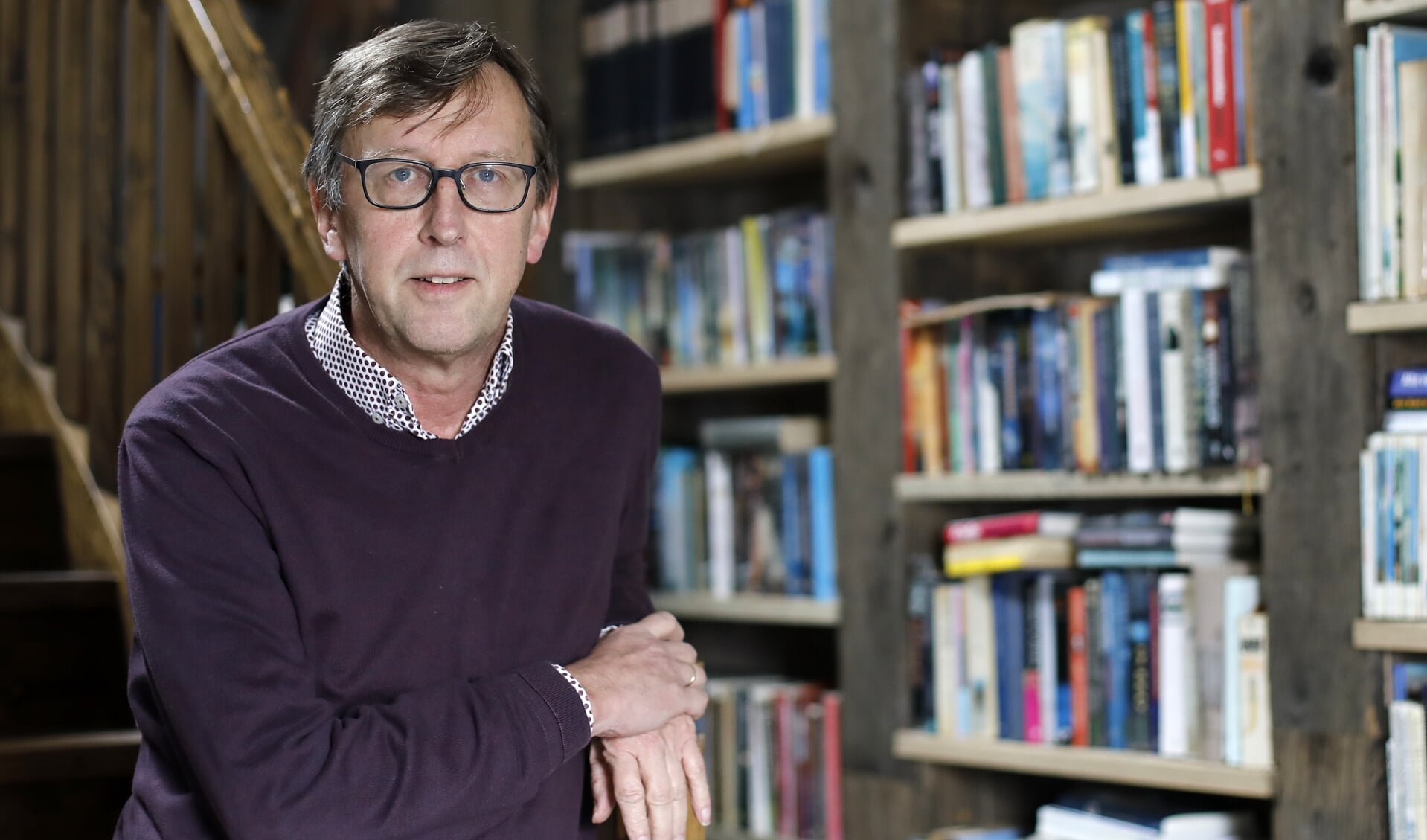BLESKENSGRAAF • Met een onderzoek naar gebedsgenezingen behaalde Dick Kruijthoff maandag zijn doctorsbul. De voormalige huisarts van Bleskensgraaf verdiepte zich – na de wonderlijke genezing van plaatsgenoot Janneke Vlot in 2007 - in dit onderwerp.

www.hetkontakt.nl
It took more than twelve years: from the first steps to the final dissertation 'Healing after Prayer, An Interdisciplinary Case Study'. Dick Kruijthoff (65) started at the age of 52. The immediate cause was the healing of Janneke Vlot from Bleskensgraaf.
For years, he witnessed her illness up close, followed by her sudden recovery during a faith healing service. “It was not the first time I experienced something like this; before and after that happened a few times in my professional period. But that was anonymous.
Permission
Janneke's healing was widely reported in the media. She herself gave permission to share her medical data. Based on this, an article was published in the national newspaper Trouw, in which the special nature of her sudden recovery is described on the basis of that medical information.
This caused a deluge of reactions. A second article in Trouw, after a call in the newspaper to share positive and negative experiences with faith healing, had the same result. Comments ranged from approving to highly critical.
Kruijthoff: “I found that difficult: ‘What should I do with this?’. I was especially curious about what exactly happens in such situations. Previously I was skeptical of faith healing rather than open to it. But certainly in the case of Janneke Vlot I couldn't just put it aside. Professor at the Vrije Universiteit Kees van der Kooi, who specialized in charismatic theology and with whom I was in contact, said to me: 'It would be nice if a general practitioner would investigate this.' That was the starting point.”
Contested area
The Bleskensgraaf GP thus entered controversial territory. The field of tension between science and religion is riddled with mines. What helped was his approach of not wanting to prove or disprove anything. “Still, it took about five or six years before the research proposal was approved in 2015.” “In addition to an extensive research of the medical literature, I went to Lourdes (a place of pilgrimage in France, where millions of people go in the hope of healing, ed.). They have been thoroughly testing the cures for years and use a very good system.”
Brazil
He continues: “In addition, I have had intensive contact with an American professor who has conducted research into healings in charismatic and evangelical congregations in the United States, Brazil and Mozambique. That provided a solid basis.” The first pillar of the research was the medical records of people who had experienced faith healing. On a call through all kinds of channels, 83 from all over the country reported. “Certainly not just from the Bible Belt.” Anorexia nervosa Five physicians (four from VU University Amsterdam and one from elsewhere, both non-religious and religious) considered their stories and selected 27. “There had to be sufficient and demonstrable data to be able to investigate objectively, such as scans before and after the healing. With the consent of those involved, we started working with their files.” What emerged from this is that the healings - as is often claimed - did not only take place on the psychosomatic level. “The registrations we received cover the full breadth of medicine,” Dick Kruijthoff nods. “That ranges from back and headaches and psychiatry to Crohn's disease, malignant diseases, anorexia nervosa and liver inflammation.” In-depth interviews Unique to the research is that the study of the medical records was linked to in-depth interviews, in order to also record the experiences of people who had experienced faith healing. “What emerged from this, among other things, is that in a large proportion of cases the healing took place from one moment to the next. A minority of these occurred during faith healing services; it also happened during personal prayer, in a prayer circle, during an anointing of the sick or even once during the celebration of the Lord's Supper. For me, this result was an eye-opener; theologian Van der Kooi even called it the most valuable result of the research.”
Incapacitated
Especially striking: most of those involved did not count on a cure at all. “A lady with all kinds of illnesses, completely unable to work, prayed desperately in the evening if she could be taken away from life. She then experienced a sense of stillness and tranquility, as if she were wrapped in a blanket.”
“The next morning she walked down the stairs and suddenly realized that it was almost effortless. In the weeks that followed, almost all of her ailments disappeared. Of the 33 pills - including morphine-like painkillers and prednisone - she now only takes one, for her thyroid.”
Placebo effect
He continues: “This argues against the placebo effect: that your physical condition improves purely on the basis of the belief that you are going to get better. And moreover, this also contradicts one of the principles in some charismatic circles when it is said that your faith is not strong enough if you do not get better after a prayer for healing.”
“Some of the people in the study were not involved in the church at all and were taken to a faith healing service by an acquaintance or a neighbor when suddenly and unexpectedly something special happened. The degree of faith plays a minor role in this.”
Feeling of warmth
At the same time, the experience went much further than not being sick anymore. The healing was often accompanied by a strong emotional and physical experience. “Many had a feeling of warmth, of being overwhelmed or of a touch at the site of the disease.”
“A lady with Parkinson's described it as if a net had been removed from her brain. In some cases there was an extrasensory perception, such as wind in an enclosed space or a vision.”
more positive
In the vast majority, the healing was a very drastic event on several levels. “People came to have a more positive attitude to life, became much more socially active, committed themselves to others or, for example, went on a mission. Faith healing is not just about getting better; it is an experience that involves mind, soul and body. That was also an eye-opener for me.”
Dick Kruijthoff immediately makes an emphatic comment: his research focused on positive experiences. “There are also negative experiences with faith healings, but they are not included in this.”
Clinical picture
Another very remarkable observation: people who can function as if they were healthy again, but where the doctor determines that the clinical picture in the body has not changed. This was the case in several cases.
“To give an example: a woman who could only walk fifty meters with crutches because of severe and progressive multiple sclerosis. After previously being skeptical, she had begun to pray more and was also planning to attend a prayer service. However, it didn't get that far, after an afternoon's sleep, suddenly and unexpectedly at that moment all complaints appeared to have disappeared.”
Professor
But an MRI scan showed that the previously observed abnormalities associated with MS were unchanged. The neurologist therefore indicated that the MS was still there. Yet she hasn't been bothered by it for fourteen years.
“We were very surprised and had this checked separately by a professor who specializes in MS, because we still had the question: 'Was it really MS?'. But he had no doubts about that.”
Sick again
The experiences also showed that after a cure not everything is rose scent and moonshine. People stay in the middle of life, can get sick again and experience other nasty things. "Or they got nasty reactions: 'You must have imagined it all, it was stuck in your head.'"
“Others ran into a burnout. It's not nothing either. From lying in bed all the time, having to be fully cared for, and then being fully alive again from one day to the next. It raises questions: how am I going to fill my days now? That's not just fun.”
Sporadic
As a general practitioner, Kruijthoff also knows very well that there are many more people who are not healed despite prayer. The kind of healing experiences he researched are sporadic at best. “However, in practice I often saw that prayer and faith also gave people strength and support when recovery failed to materialize. And I thought that was also special to see.”
Faith healings are viewed with some reservation in many church congregations. As far as Dick Kruijthoff is concerned, the research underlines that this is unjustified. “Much more use could be made of, for example, the Anointing of the Sick. It is a beautiful instrument from the 'toolbox' of the church, as Van der Kooi describes it.”
Medically remarkable healing
In conclusion, of the 27 cases examined, the medical review team concluded that in 11 cases there was a medically remarkable cure.
The label scientifically unexplained cures, which cannot be explained on the basis of medical-scientific knowledge, was omitted. Although the dividing line is thin, Kruijthoff admits. Or, as the book's summary states: "Medical explanations are not sufficient to understand the healing experiences."
Miracle
He finds the word miracle difficult, there are so many conflicting opinions about it. “The faith healings that I have researched have caused great amazement and have encouraged me,” he responds.
“Recently I spoke to a woman who, as a non-believer, cried out to God and, to her great surprise, was suddenly healed. After that, faith became an important source for her, also to help people with fewer opportunities. The experience still marks her in a positive way. That does me good.”

 research.vu.nl
research.vu.nl


